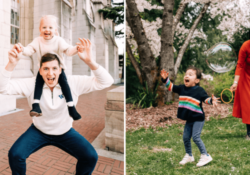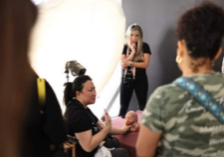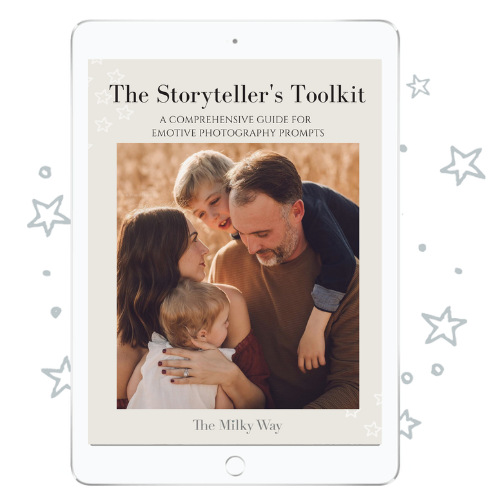Business Tip Road Trip: 7 Photography Experts Offer Heartfelt Advice to Improve Your Photography Business
Have you ever wanted to improve your photography business and learn from other experienced photographers? There’s a lot of information out there to sift through and it can be overwhelming, I get it. But what if we could compile our best, most effective tips in one place? Intrigued? Get ready for the Business Tip Road Trip!
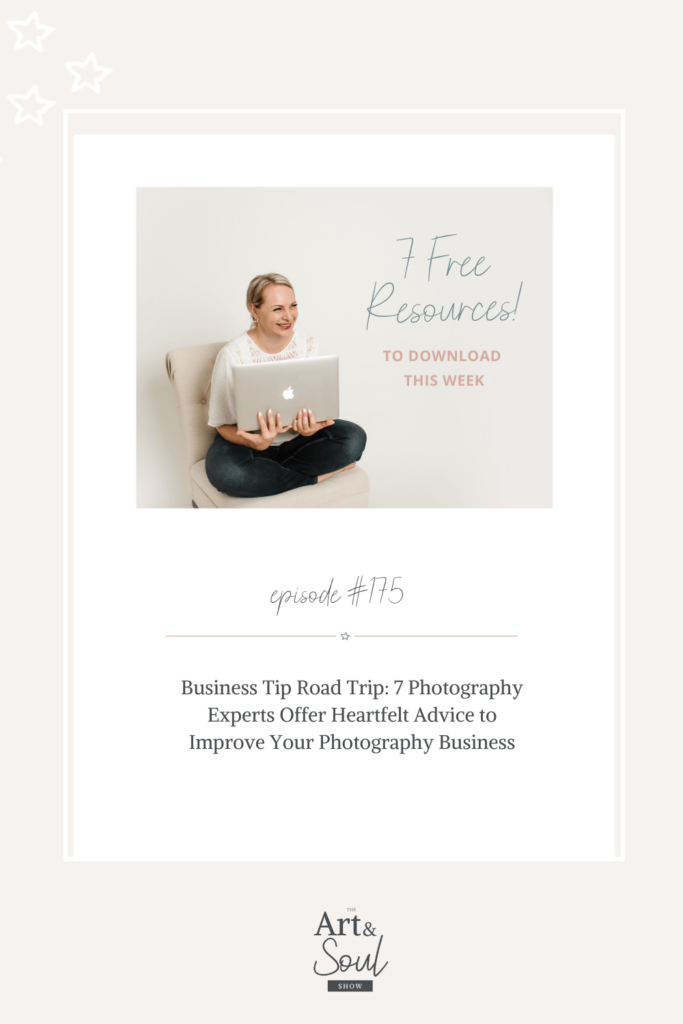
Today’s episode is a bit different from what you would normally hear on the Art and Soul Show, but I know it’s one that will be so valuable. It’s a collaborative episode featuring 7 expert photography business owners (yours truly included!) who are offering tips and advice on how to improve and streamline your own business. Make sure to bookmark this episode and return to it again and again as you implement these strategies.
We’re dropping serious knowledge on topics like defining success, SEO, booking clients, finances, time management, workflow, and boosting your revenue. If you have a photography business, this episode is one you cannot miss!
What’s in this episode:
- [02:06] Sabrina Gebhardt (Shoot it Straight) kicks things off with a really important topic that many of us ignore: how to define success for ourselves (instead of letting others define it for us).
- [10:13] Andrew Hellmich (Photo Biz X) shares a clever tip for how to use video content to give your SEO a mega boost!
- [22:58] Colie James (Business First Creatives) shares tips for booking more clients with a simple (yet wildly effective!) two-step process.
- [32:24] Daniel Moyer (Focused Photographers) talks about the ups and downs of finances as a service-based entrepreneur and shares a great tool for getting your finances in order.
- [44:06] Lisa DiGeso (The Milky Way) talks about strategies for managing your time and creating the work/life balance that you’ve always wanted.
- [56:02] Natalie Jennings (Photo Business Help) pulls back the curtain on tips & tricks to use Pic-Time that will improve your workflow and knock your client’s socks off.
- [59:36] And finally, Annemie Tonken (This Can’t Be That Hard) shares the brilliance of using a “Back Pocket Offer” to give your revenue a boost this year… even in a slow economy!
Tune in to this episode for new tips on this Business Tip Road Trip episode to implement in your business from 7 expert photographers.
SUBSCRIBE: Apple Podcasts | Spotify | Stitcher
Want to put an end to awkward moments in your photo sessions and create genuine connection? Download The Storyteller’s Toolkit today, featuring 200+ emotive photography prompts, so you’re never left wondering what to say.
Resources Mentioned
Sabrina’s Freebie: 9 Steps to Set Yourself Up for Success
Andrew’s Freebie: How to Book More Portrait Clients
Colie’s Freebie: How to Optimize Your Offer
Daniel’s Freebie: Finance Focus Steps
Lisa’s Freebie: The Yearly Planner
Natalie’s Freebie: 8 Things To Grow Your Photography Business
Annemie’s Freebie: The Guide to Phone Call Magic
Did this episode inspire you to implement and try new tips from our photography experts in your business? Check out this episode SEO for Photographers: Why You Need It & How to Get Started with Corey Potter which offers you even more insight on finding alignment in your business!
Transcript
[00:01:22] Lisa DiGeso Welcome to the Art and Soul Show where we dive into heart opening chats on photography, business life and that messy in between. I’m your host, Lisa DiGeso, a mom, a photographer and entrepreneur, and I’ll be sharing honest conversations and advice for photographers with insight on mindset, entrepreneurship and creativity. The goal of this podcast is for you to be able to gain insights and strategies that will get you real results. Because let’s face it, having a photography business can be lonely, but it doesn’t have to be. This is the place you can go when you need a boost of encouragement, a kick in the pants and inspiration to pick up your camera. This is the Art and Soul Show.
[00:02:06] Sabrina Gebhart Hi, my name is Sabrina Gebhart. I’m a lifestyle family and newborn photographer of more than 12 years in Fort Worth, Texas. I’m a podcast host of the Shoot It Straight podcast, and I’m also a business coach. Today, I want to talk to you about knowing your definition of success. So if you were to Google, what makes a photographer successful or when is a creative entrepreneur successful? There’s literally no answer. It’s all relative and made up. It’s time to define what success means to you and what actually matters to you. It’s so easy to start our businesses and start to define success around the baseline of others. We all here have a six figure year or get published an X, Y, Z, or win this award or get this distinction or only work three days a week. Or, or, or. But what if those things don’t feel good to you? Or what if you literally don’t care about them? Or worse? What if you’re striving toward them and you actually don’t jive with them at all? What matters to you in your life with your family and your commitments? Today I want to walk through what creating your definition of success actually looks like. And it all starts with having a clear vision. If you can envision your most successful business in a year from now, if you had all green lights and things were straight up success for the next year, what would your business and your life look like? I invite you to get really detailed with this vision. What are your days feel like? How much are you shooting? What kind of photography are you doing? Who are you working with? How often are you working? Do you have a team? How much are you making per client? What are you paying yourself? What is your content creation process feel like? What do you feel like when you are photographing clients? Are you inspired? Do you have time to volunteer at your kids school? Do you have hobbies? Are you traveling? Literally. Go deep here and define what makes that picture of success uniquely yours and then write it all down. If your vision looks like photographing three families a week and they’re paying you $1,000 per session and you’re taking a small family vacation every quarter and your work feels consistent and fine tuned and you’re having to turn away inquiries and you don’t have any guilt about that because you are so certain with where you stand and what your boundaries are. That definition allows you to write the rules. What matters to you might not matter to me. Creating your own definition is about pulling back and doing some real hard work. What matters to your family? What matters to your future? What matters to your career? If you want to work less or work more, or travel, do you want to be intentionally part time? Do you want to be able to financially retire your partner? Do you want to start coaching? Do you want to niche down? Do you want to afford hiring a chef and a personal trainer? Do you want to work with celebrities and big brands? Literally. What does your life look like? Define that vision and then lean into those parameters. Thanks to social media and the Internet, we are bombarded with what everyone else loves and is doing and is striving for. And it’s so easy to put those desires onto ourselves, even when they don’t actually matter to us or fit our vision. The second part of knowing our own definition of success is being able to clearly identify who we are. This may sound dumb, but again, in our busy online world, it’s super easy to get lost. I bet you think about your business or your personal opinions and you may actually be a bit confused on at least a few of them. Do you really love everything that you’re doing and offering and all the ways that you’re choosing to spend your time and what you’re spending your money on? Or are things just happening to you? And you have in turn found yourself going along with them kind of mindlessly. Or maybe you found yourself somewhere that you never intended to be. It is so important to know who you are and what you want before you can go any further. Every decision you make, every goal you set, every step you take depends on knowing exactly who you are and what your vision is. And if you don’t know who you are and what you want from this life, you will continue to struggle moving forward at all. The perfect example of this is Julia Roberts in the movie The Runaway Bride. If you haven’t seen this movie from the late nineties, I highly recommend it. It’s an oldie but goodie. The premise of the movie is that Julia Roberts character has been engaged several times, and every single time she runs away on her wedding day. It turns out she has reinvented herself so many times over the years to match her various fiances personalities and lifestyles that she’s lost herself, and she doesn’t know who she really is deep down. In fact, she’s so lost that she doesn’t even know what type of eggs she prefers. She walks through this process of self-discovery and makes dozens of eggs in every imaginable manner so that she can learn what she really likes. Just like Julia Roberts, we so often take on roles or goals that look great on other people. But at the end of the day, are they really aligned with your vision? A good way to gain this self-awareness is to do a small or maybe a large social media fast. Just take a few days off and disconnect the quiet and the noise. Doing this allows you to gain clarity on what you actually care about, what feels good to you and what you don’t like. It also gives you clarity on what your gut is telling you. Once you know what your vision is and who you really are. Your definition of success becomes very clear. And clarity is such a gift. This is what helps you know what to do every day, every month, every year. This is how you hit goals. This is how you stay on the right track. The best way to keep this clarity on your definition of success is to write it down. You’ve probably heard that when you set goals, it’s really beneficial to keep those goals top of mind for the highest rate of success. Like having them on a sticky note on your desk or on a bulletin board where you can see them daily. Same thing goes with your definition of success. Having those details clearly noted in words or on a vision board where you can see them every day, that is what is going to give you clarity and focus. That is what is going to keep you in your own lane instead of constantly being distracted by what everybody else is doing. That is what helps you take intentional action steps toward the business and the life of your dreams. So to wrap up in order to clearly define your version of success, first, you must know your vision in a perfectly successful world. Where do you want to be a year from now? Two years from now? Let those dreams cast your big vision. Second, know who you are. What deeply matters to you and what doesn’t. What lights you up and what you are no longer available for. And third, use your vision and who you are to clearly spell out what a successful business and life looks like and have this displayed so that you can keep your eyes on the prize and filter all your decisions through it so you can stay on track. Knowing these things deeply matters. You chose to become a photographer because you wanted to lean into your passion for photos and have a business that aligns with you. Don’t waste another minute chasing someone else’s definition of success. Thanks for listening. And before I go, I’d love to offer you a free download. My photography business blueprint is nine steps to make sure that you are set up for sustainable long term success in your business. You can grab that at sabrinagebhart.com/blueprint.
[00:10:13] Andrew Hellmich Hey, it’s Andrew Hellmich here, host of the Photo Biz X podcast, where I interview guests, photographers, business experts from around the world to help you grow a better photography business even faster than going it alone. And I am rapt to be here with you today to share an idea that I heard from an SEO expert. I implemented this myself and had incredible results. And what I’m talking about is ranking on page one of Google for a search term that you’re looking to rank for utilizing YouTube and video to shortcut the SEO process. One of the things that does scare so many photographers away is actually implementing the ideas they hear. What I’m going to suggest that you do is think a little bit smaller so you can test the idea that I’m presenting to you. See if it works. Prove to yourself that it works and then go bigger with it. You can scale it once you know what to do. So let’s say, for example, I’m going to use myself here as an example. I live in an area called the Central Coast and one of the most popular and sought after search terms would be Central Coast wedding photographer, for example. And that’s a tough keyword to rank for, particularly if I’m new to the area or if I’m new in business. And there’s been businesses, other wedding photographers that have been established here for a long time. What I will do and what I’m going to encourage you to do is to think of the area where you live and then think of a smaller area inside that larger area that you would want to be able to rank for and that you can test my strategy on. So for me, inside the Central Coast area are a number of different suburbs. One of them is Terrigal, which is the suburb where I live. It is also one of the most popular suburbs for wedding photos and also wedding venues in my local area in the Central Coast. So that was the specific area I’m going to be targeting and I’m going to be looking to rank for the keyword phrase Terrigal Wedding Photographer. So I want you to do exactly the same. Come up with a smaller area inside the larger area that you can go and test this process. And then what I want you to do is go out with your phone. You don’t need to use your SLR or your mirrorless camera and go and film a series of four or five or six little videos in your local area. So for me, I went to Terrigal Haven. It’s a popular spot where couples will go for their wedding photos on the wedding day. And I went to four or five different little locations in the terrible Haven area saying why each of those different areas would be suitable for wedding photos depending on the wind direction, the time of year, how busy it will be for the type of photos that you want to have, whether it’s beachy sand, whether it’s rocks, whether it’s cliffs or grassed areas. So I just went to each of those different locations, put my camera in selfie mode, or you can have one of your kids or an assistant hold your iPhone or put it on a tripod, and it’s just you speaking to camera. You’re saying to your prospective couples or your prospective clients at this point, no matter if you are a wedding photographer, a portrait photographer, a pet photographer, a newborn photographer, whatever it is you want to rank for, and the area that you want to rank for, you’re going to be speaking to your prospective client, talking to them about the location that you’re recommending. I’ll give you some other ideas if you photograph other genres apart from weddings in just a second. So in my case, I went to each of those different locations, recorded a 2 to 4 minute video saying why I recommended each of these locations. Now, when I was doing that, and you will do the same, you will automatically use the keyword phrases that you’re looking to rank for without having to try to. You don’t need to jam pack your video with keyword phrases. You just talk as if you would normally talk. So I would say something like, Hey, it’s Andrew here from Impact Images. I’m down here at Terrigal Haven on the Central Coast, and I want to share with you why this is one of the best spots for wedding photography on your wedding day. And I go into the reasons why and again, these are nothing elaborate. They’re just shot on my phone. One thing you will want to be aware of is the audio quality. You want to have good audio quality because you do want people to actually be able to watch your videos and get something from them. Now you can use AirPods, you can use the headphones and microphones that came with you with like the earbuds and microphone that came with your phone. You can go to something a little bit more elaborate if you want to, but you don’t need to to start with. Just make sure it’s not too windy and you have good audio from your recording. So if it’s a windy day, just wait till it’s not windy. Go out there late in the afternoon or early in the morning. You want to have decent audio quality. Now for me, when I filmed my videos, I wore the same t shirt, the same sunglasses. I looked exactly the same in each of my videos. So again, I didn’t change, nothing elaborate about these videos. It was just a couple videos for prospective clients looking to have their wedding photos done at Terrigal Haven. Now once you have your videos, you can edit them and you can do that in iMovie. If you want to do this on your phone, there’s a great app called Cap Cut, C-A-P-C-U-T. It works on Android and iPhone. It’s a fantastic way to edit videos from your phone. Again, you can do this on your laptop or desktop as well. Once you have your video edited, you want to upload it to YouTube. Now, if you don’t have a YouTube channel, it’s free. You can set one up. You don’t need to get caught up with making your page, your YouTube channel page look amazing. At this stage, we just want to get your videos uploaded. So you’ll upload your video, start with one and then it’s pretty intuitive from there, you just need to complete the different boxes and options that YouTube presents to you. You want to make your video public and available to everyone. And again, you don’t need to have any fancy splash screens or starting or ending screens, any fancy graphics. This is just a talking head. It’s you talking to camera. You honestly do not need to do anything fancy to test this idea for yourself. Now you have your video uploaded. This is the most important part. You need to complete the captions area on your video. Now, this is where you would write a mini blog post, pretty much saying what you said in the video. So again, you don’t need to be elusive here and try and push people to watch your video. You can actually write a mini blog post covering what you did cover in the video. Now, the most important thing is to have a link pointing back to your website and you want to make sure that link is a hyperlink. So you need to include the HTTPS, or the HTTP:// and then the URL to a website. It needs to be a clickable link inside those YouTube captions. Now I’ve just said captions a couple of times and what I meant to say was the description. So if you’re in YouTube, you’re adding to the description, so you’re going to have a mini blog post, a link pointing to your website using the HTTPS, and then you click publish and the video is there on YouTube. Now what you want to do next is go to your website and create a blog post on that same topic. You can slightly alter the headline, but you do want to use that keyword phrase they are looking to rank for. And then you embed the YouTube video into that blog post. So YouTube is where the video is hosted, but you’re going to embed the video on your blog post. And if you have any troubles with that, you can contact your web developer. It should be pretty straightforward. You’re going to just embed some code and the YouTube video will show up in your actual blog post. Now, we also want to do is rewrite your blog post about the video again, and it can be slightly different. You don’t want to just copy and paste what you posted for your YouTube description. You can modify that slightly. Again, it’s going to have the keyword phrases that you’re looking to rank for organically appear as you’re typing out your blog post. So now what you have is a video based around the keyword phrase you’re looking to reinforce. So for me it was Terrigal Haven wedding photography and I now have five or six, I think it was five or six different videos around Terrigal Haven all posted on YouTube. I have five or six separate little blog posts on my website using the same keyword phrases, all with those YouTube videos embedded. Now, you could also have all six videos inside the one big blog post as well on your website that would work equally well. And that is it. You are done. Now the next step is to wait for Google to crawl your website and what happens and also crawl YouTube. Now, you may not be aware that YouTube is the second largest search engine out there in the world. It’s owned by Google. So Google, as we know, like any other social media platform, they want us to be publishing videos. They want to show video replies or video solutions to people’s search queries. Now, if you had videos based around the search terms you’re looking to rank for, YouTube would show those videos on page one of Google. If those videos are available in YouTube, it works beautifully well, and honestly, you have to go and test this for yourself to see how good and easy it works. It’s not complicated. It’s not difficult. You can do all this in one afternoon and get it done for yourself. But I’m going to encourage you again to test this on a smaller location before you start going bigger with it. So you can prove to yourself that this works and then you can go as hard as you want with this. Now, if you are not a wedding photographer and you still want to be ranking for your genre of photography in your location, then you need to think of some other different ways you can talk about those locations. It’s pretty simple for a family or a pet photographer. You can talk about different locations. If you’re a newborn photographer, let’s say I’m based in Terrigal, I’m a Terrigal newborn photographer, I can talk about the different props that I use. The way my studio is heated. I can do a separate video on where my studio is located, how good and easy the parking is, and all the while I’m using Terrigal newborn photographer or Terrigal newborn photography while I’m talking about my studio, my business, how I can serve you as a prospective client. There are so many different ways you can spin this, but the main thing you want to be doing, if you want to rank for your location genre photography, then you need to create some videos around that genre. Stay small with it to start with, test it, give it a week or so, see where those videos rank. They should be on page one of Google within a couple of weeks if you do this correctly. And then once you’ve proved yourself that it works, you can go bigger and bigger with it, expand your areas, create more videos. In fact, when I did, I started interviewing other service providers in my local area. So as a wedding photographer, I interviewed the bridal operators, florists, different reception venues. Makeup artists, hairdressers, hairstylists, you name it. I interviewed those people and what happened was impact images. My photography studio started ranking four Central Coast Wedding Florist, Central Coast, wedding cars. It was ridiculous. Impact Images was coming up because when I interviewed those different service providers, I was asking them the questions that a client or perspective client would want to know. So, if I’m going to hire some cars. I was asking, how much does it cost? When do I have to book? What cars do I have to choose from? How long do I have to have the cars booked for? What’s the minimum? What’s the maximum? Can the cars go home then come back and pick me up from the reception afterwards? Can I have three cars take us to the ceremony, but only one car pick us up at the reception? I was just asking all the things a client would want to know the answers to, creating a YouTube video, then creating a blog post on my website, linking the two together. And sure enough, I was ranking for those search terms with my photography business, even though I don’t have cars for hire, I don’t do flowers. I’m not a makeup artist. I was ranking for each of those terms. This is super, super powerful. Give it a try. I’d love to hear how you get on with it. And I have to say, just to finish off, this isn’t my idea. I got this from an interview with Gabrielle Mortuary, which I’ll give to Annemie to link to. You can go and check out that interview yourself. I just ran with his idea and it worked incredibly well, and I hope it will be, too. Again, it’s Andrew here from Photo Biz X, and I’ll talk to you soon. Bye for now.
[00:22:58] Colie James Hey, y’all. I’m Colie James, host of the Business First Creatives podcast. My number one business tip I want to share with you today is to eliminate booking friction in your business. I know that sounds like a really big thing, but I am going to break it down into two different things that you can do in order to achieve this. So number one, I want you to optimize the offer. And number two, I want you to automate the booking process. Now, if you’ve ever heard me talk about CRM, you probably know what’s coming with number two. So let’s start with number one, how to optimize that offer, guys. Getting people to say yes is typically not about your price point. It’s more about how you present the offer and how easy you make it for them to say yes. Each and every time they have to wait for you to answer a question, for you to give them the next step, you are taking the chance that they are going to fall off, walk away from the process and completely ghost you, which none of us want people to walk away. So if you are not clear and concise in your offer, they will have questions each and every time that they wait for an answer, or a clarification, you decrease the chance that you are going to convert them into a paid client. Now, I know some people say, Oh, but my website does a really good job. Not everyone is going to read your website. Oh, but I do consultation calls. That’s true. But people need to process it in an auditory way and then they also need to be able to read it. So I’m going to say it does not matter what you are doing in your processes before you make the actual offer. When you send them the proposal or the quote, you still need to reiterate some of the things that you may have already told them, and you can totally recycle some of the information already on your website to do this. So here are a few of the things that I believe you need to include in your offer in order to maximize the chance that they will convert into a paid client. An attention grabbing headline. Now, I know it sounds like I’m a website copywriter, but the things that get you to say yes on the website are the same things that are going to get them to say yes when you present the offer and they actually have to pay you money. So I have a few that I use. One is stress free photo sessions that no one will whine about. That’s my first headline. My second headline is that you deserve to be in the photos, too. Now, those are talking to two different clients that I typically get. One, they don’t like photo sessions. They feel like their entire family stresses them out. Everybody whines. Everybody is worried about whether or not it’s going to be a good experience. Those people need to be told that I can provide a stress free environment and beautiful photos to go along with them. The second set of people that I am trying to get to, and I know that most of the time it’s the mom, but I actually have quite a few dads who are the documentarians in their family, if you will, and that’s the you deserve to be in photos too. I am trying to remind them that no matter how good you are with your iPhone or even if you are a professional photographer, you are not in all of the photos because typically you can’t take the photo and be in the photo at the same time. Okay. The number two thing that I want you to do is to address any objections that you typically get during the actual booking process. Now, if you are newer to photography, you might not have a very long list of what those objections are. If you need to leave that off at this time, that’s okay. But every time you present an offer to a potential client and they push back, they ask additional questions, you should be keeping a running list of what those questions are and how you address them so that it can become part of the offer. The next thing is what we all expect to see in our proposal, in our quote, and that’s the actual offer and the details. But I think where a lot of us fall off is that we tell them what we’re going to give them, but we don’t remind them why. And in the case of photography, like we’re giving them a set of digital, perhaps we’re giving them the opportunity to have products or maybe you have some included. But the fact that you get to be in the photos and that their grandchildren will see them and their grandchildren’s grandchildren will see them. You do have to make sure that they understand the value of the photos beyond the file. And then testimonials. Guys, every time someone leaves you one of those awesome testimonials. I’m not talking about the ones that say “Colie’s awesome” because those don’t really give detail. Those don’t really give context. Those don’t help to address some of the objections that this potential client may have. So if someone says, I was nervous, but Colie made my entire family feel comfortable, that’s a testimonial that you want to put somewhere on your proposal. Okay. And then the timeline and the process of working with you. You never want your clients to be unsure of what happens after they pay you the money. So if you’re going to send them a client questionnaire, tell them if you send them styling help or they’re going to have to get on a planning call with you, tell them that. You do want to outline what you expect from them and also what they can expect from you between the time that they pay you the actual money and when the session actually takes place. Now, this next section that I want you to include in your offer is add ons and upsells. But I do want to give you two perspectives on this. Number one, you can always ask for people to upsell, to buy additional time, to buy products, whatever it is that you typically add on. But I want to tell you why I don’t do that anymore. Part of eliminating the booking friction. I just want someone to say, yes, we can get into the nitty gritty of if you want me to do a film in addition to the photos for you, after you book, we can get into whether or not you want to buy an album from me after you book. I actually like to make the saying yes as simple as possible so that we can get to planning and then we can talk about what else I can do for you after you’ve committed to being my client. Because every single time that you allow them to consider another option or something in addition to your main service, again, you might give them decision fatigue. And then instead of just picking one, they decide not to hire you altogether. And then my last but most frequently overlooked section is your frequently asked questions. I used frequently twice. Guys, there are questions that people are going to ask you over and over again. Do you offer payment plans? What happens in the case of weather? What are your rescheduling policies? Can I forfeit my print credit for a discount? These are all things that people may think as they move down your offer in order to say yes. And so anything that you can think of ahead of time that they would ask you, if you put it in the frequently asked questions, you eliminate the chance that there’s going to be booking friction and that they’re going to need to send you an email before they complete the booking process. So, guys, those are all of the things that I want you to include in your offer in order to optimize the chance that they will say yes to you. I know it seems like a lot. I know that you may have some of this in other parts of your booking process, like your website or your consultation calls. But reminding them of all of this and why you are the person to solve their problem, which in this case is to give them family photos that they can enjoy, their future generations can enjoy, etc. Giving them that information when you ask them for the money is what closes the deal in most cases. So now that we’ve talked about how to optimize your offer, I want to very briefly talk about how to automate it. It’s simple, guys. If you already have a client relationship manager, a CRM, you have the ability to send the offer, the contract and the invoice in one step. Different CRMs connect them differently. But every single CRM on the market that photographers consider for their business at this point, pretty much all of them include the proposal process that automates getting them to say yes, getting them to sign a contract and getting them to pay money. No more send me my money via Venmo. No more oh, you say yes and then I customize this contract and I send it for you to sign. Guys, we want all three steps to be in one easy process that they can complete in less than 5 minutes. I love Dubsado because it allows you to include all of the information that I told you to optimize the offer within the proposal. You can also optimize all of that stuff within a brochure in HoneyBook. Unfortunately, not all of this CRMs are going to allow you to add in all of these different items and include pictures or videos as applicable in your CRM, but just make sure that you check out the CRM that you’re currently using and see what features it has available. If you would like additional information in how to optimize your offer, I do have a freebie for you. Go to coliejames.com/roadtrip. One word. That’s it, guys. Thanks.
[00:32:24] Daniel Moyer Hello, dear friends, I’m Dan Moyer and I host the Focused Photographers podcast and I’m so thankful to be here with you and to talk to you about money. And the reason why I’m here to talk to you about money is because it’s weird to talk about. It is difficult to talk about because we all have so many different experiences with it. We have different levels of confidence with it. Some of us, I think, you know, have a false sense of confidence with it. But the moment that I realized that I needed to spend more time and more effort discussing money on my platform is when I asked my community to describe their relationship with money in one word and the responses were overwhelmingly negative. They were like frustrating, overwhelmed, anxious, anxiety inducing, avoidant, toxic, clueless, confusing. On and on and on and on. And to be fair, there were some positive, pseudo positive ones. Like, you know, that money provides freedom, that it’s necessary and things like that. But for so many of us, our feelings about money and where we get it from comes from the stories that we’re told by family members. They come from our the experiences that we have in our impressionable years and an unending list of other factors. They result in the stories that we tell ourselves about money, the good stories and the bad stories. Now, I’ve got quite a story that I could share about, you know, my journey to sort of financial freedom from having, you know, over $100,000 of personal debt, not including our house to being able to pay off $75,000 of that debt in just four years. If you want to learn more about that, go to focusedphotographers.com/ff. FF stands for finance focused. So go to focusedphotographers.com/ff. It basically goes over the books that I’ve read and sort of the steps that my wife and I put into place to really take control of our finances, both in my business. So I have a system in my business for managing where every penny goes and then a system in our in our personal lives for managing our money and budgeting. So like I said, if you want to learn more about that, go to focusedphotographers.com/ff and you can download those exact steps in a little PDF workbook that I created just for you. Okay. So skipping past my personal story, I’m not as interested in things like how to invest and you know what to do with your money. I’m not an accountant. I’m not a CPA. What I’m more interested in is the stories we tell ourselves about money. Because each of us has a script, a tape that plays in our head. It’s a set of beliefs that we have that live rent free in our minds that keep us from living and making meaningful progress. This script really plays out in these four money mindsets. Officially, it’s called the Klontz Money Script Inventory that was created by this guy, Brad Klontz. But I think that they are they’re basically for money mindsets and they are money avoidance, money status, money worship and the money vigilant. And I’m going to go through each of them now and see as I go through them what sort of sticks out. Okay, money avoidance is the first one, and that was me to my core. This is the most detrimental of all mindsets at its core. Basically the money avoidant belief that money is evil and it corrupts people. They believe that wealthy people are greedy. They think that there is virtue in living with with less money and less stuff. But the problem is, is that they’re they secretly want to be free of it. They want to not have the shame of of like not knowing about their finances, but they live in this like negative feedback loop. And the negative feedback loop goes like this. They have shame about their finances and they neglect looking at their bills due to the financial stress that they know they have. So they overspend to make themselves feel better. Which leads back to the shame and back to the top of the wheel and just continues going over and over and over again. The money status people, basically it’s this one very simple phrase your net worth equals your self-worth. These individuals, the money status are more into displaying their wealth than anything else. They probably have little or no savings, they’re likely caught up in buying things that will increase the status of themselves in the eyes of others. Like they’ll buy the newest gear, the newest phone, new clothes, shoes for every day of the month. My friend Joy Michele or Joy Aleman, she’s known as Joy Michele Online. We talked about this in her Facebook group. It basically says that if you’ve ever gone past a house that has like the had the car in the driveway it looks like it’s more expensive than the house. She calls that big hat, no cattle, which I love. But that’s money status that your net worth equals your self-worth. Next is money worship. This one’s tricky. It is similar to money status, except that money worshipers believe that their lives are going to significantly improve if they just have more money. That is a core belief that money is the key to happiness and the key to their happiness. And they tell themselves that wealth is freedom. They tend to put work ahead of family and think that the more they work, the more money they will make. And this is a very difficult problem for a lot of photographers, as we feel so tied to the more weddings we shoot, the more sessions we shoot, the more money we’re going to make. But here’s where things get really tricky. There’s a feedback loop that these money worshipers get stuck in as well. It’s a cycle of money and work and stress. It’s basically that the more the more they work, the more money they get. But they never feel like they have enough money so they don’t spend enough time with their family members or do anything else outside of work because they’re working so much. So they work more to buy their freedom so they can spend time with their family. And on and on and on it goes. But the most difficult part of this is that the money worshipers have difficulty seeing their struggles because they don’t view their negative thought patterns as quote unquote, worship. The last one is money, vigilance. Now, this is considered the most healthy of all the mindsets. It basically says that the money vigilant are aware that money is very helpful in life, but it’s only what you make of it. The money vigilant. Recognize money is a powerful part of making life easier in general, but also recognize that money itself does not bring happiness. The money vigilant focus on building wealth. They encourage saving and frugality. They rarely use credit. They look for bargains and spend within their means. The money vigilant typically have a protective and positive mindset, but this also can lead to an over fixation on their finances, which can hinder the money vigilant from reaping the full benefits of their positive finances. So let me just put this also simply. Here’s these four money mindsets. Money avoidant, money status, money worship, money vigilance. Here’s what we’re trying to get to. A positive relationship with money looks like understanding the power of money and how it can be used for good. And looks like taking steps to build wealth such as investing and saving and budgeting, and also recognizing that money is not a source of fulfillment. It looks like embracing financial freedom and building the confidence really, to make smart financial decisions. It looks like being mindful of spending and budgeting along your values and then ruthlessly cutting everywhere else. And my favorite part is it looks like being aware of the stories we tell ourselves about money and taking control of our own narratives. And let me just say that part one more time, because I think this is a big part that’s going to come up next. It looks like being aware of the stories we tell ourselves about money and taking control of our own narratives. Now, before I get into this next part, I’m not naive enough to say that you’re going to do these next four things and everything’s going to be totally fine. You may have some deep seeded stuff that you need the help of a professional to work through, and that’s where a good counselor or a good therapist can help you unpack some of them. I’ve been in therapy for over two years. It’s very helpful for me and we’ve definitely unpacked some money stuff with my therapist. But here’s sort of a few things that I think are broadly applicable based on my own experience. Here’s some steps to start overcoming and working through your negative money mindset. If one of those stuck out that we went through. The first step is to identify the problem. The next step is to ask yourself questions to understand that problem. Third is to pinpoint the lie you’re telling yourself. And the fourth is to reframe it. So in my own personal life, my problems several years ago were that I was spending way too much money on the stuff that I didn’t have money for and didn’t need, and wasn’t part of the values I really had in my life. I was spending money on eating out way too much, especially with my clients are spending too much money on coffee like an insane amount of coffee. I’d go and start working in the morning and I would stay there for lunch. I’d get multiple coffees, 30, 40 bucks several times a week, adds up to be a lot. I bought the gear I didn’t need. I bought tickets for first class. It was ridiculous. What was actually going on is I’m starting to ask myself questions about this is that I really cared a lot about what people thought of me. I wanted to look successful right away and at a deeper level I was scared of having too much money. I was scared because I didn’t know how to manage it. I didn’t understand the taxes, investments and all that scary stuff. And this came from the lies that I was telling myself. And here’s how I pinpointed my lies. I believe that my parents, who worked extremely hard, they worked two jobs. I remember my dad hustling as Spurs manager, and then he’d go and work at like Sears selling siding at night or something like that. And they worked so hard and so often, but it never felt like we were getting ahead. So I thought, well, if my parents didn’t make great money, why would I make great money? I also believe that through seeing things in my impressionable years, in my middle school years, that money will change me and make me a bad person. And I also told myself that I was impatient and I wanted success now and all those things if you look at, you know, what was actually going on, they all feed into each other. But I looked deep and I said, I’m telling myself the wrong stories. I can tell myself new stories and look at my situation in a different way. So I reframed all of them. I said, My life is not my parent’s life. I have more opportunity, more education, and I can be the change I want to see in my life. And I spent time thinking about that and editing on that. And I wrote these things down and read them regularly. This next one, it was that money is neutral. It does not have power over me. Money is just a tool. And there’s often this like very misquoted Bible verse that says, you know, money is the root of all evil. First Timothy 610 actually says, for the love of money is the root of all evil. Money’s just neutral. It’s just a tool. It’s the obsession with money that changes people. It’s the obsession with power that changes people. Money is a very powerful tool, but I can use it for good. And that is how on a very basic level, we start to overcome the stories that we tell ourselves about money and how we deal with it. And I know this is like a very surface level, like 500 foot view of this. But the next thing after you start reframing this is to grow in confidence around your finances, read books, listen to podcasts, go to my website, focusedphotographers.com/ff and download the finance focus steps that my wife and I used to get out of debt and just start increasing your confidence around it. Change this mindset first and then start budgeting. Then just start really increasing your confidence by putting into action the things that you didn’t believe that you could do that now you can start doing because you are building the confidence. You change your mindset first and then you can get into action. I hope this is helpful. I’m so thankful that you are listening to this episode. You can find me at focusphotographers.com. You can also follow along on my Instagram at getfocusedphotographers. If you have any questions, hit me up [email protected]. Make it a great day and I’ll talk to you later.
[00:44:06] Lisa DiGeso Hello my beautiful friends. I am so excited to be a part of this collaborative episode. Now, if we haven’t met yet, I’m Lisa. I’ve been a photographer at my company, Milk and Honey Photography for over 13 years. I’m the co-owner of the Milky Way, a photographer’s resource, host and producer of the online retreat series, podcast host of the Art and Soul show, wannabe Yogi, avid book buyer, and education junkie. I am a curious cat. I’m always exploring and researching something, and I’ve never been a color inside the lines kind of girl. I look at the world with a sense of humor and have never taken off my rose colored glasses. This is the kind of art I create, and that’s the kind of businesses that I run. Businesses run with intention, integrity, heart and soul. I am very proud of our students and I really get lit up by their transformations, confidence, and their belief in themselves. My purpose is to create, empower, educate and entertain. And I am happiest when all of those blend together. So today, I’m going to share with you something that really is near and dear to my heart. Time management for photographers. Now, the reason I love this topic so much is because while I probably have a master’s degree in procrastination and just spinning my wheels when it comes to managing myself and how I spend my time, because with running two businesses and a family, I had to out of necessity. Now, over the years, in order to get everything done, I really had to come up with strategies that work for me because truly, if I don’t have a plan, I really can spend the entire day just letting myself distract myself and instead of getting anything done, I just spiral down a rabbit hole or researching when cheese was first invented and then I just start to feel aimless and unproductive. And that honestly just leads to a lack of motivation and really just a loss of momentum. And that’s not the high energy vibe I really want in my businesses. So in this episode I’m going to share with you my favorite tips on how I actually manage my time and stay motivated. Now I really like to start with a thought download. Now, really, this is a brain dump. This is a technique where you purge everything that’s in your head onto paper and your brain is supposed to be a processor, not a storage container. And if our brains are full of all the things we’re trying to remember from your three year old’s dentist appointment to the props your client texted you at midnight to pull it out their session. It’s honestly counterproductive and super unrealistic to think you can remember it all. We are literally gumming up our system. So by getting it all out, you can really start to see the things that you’ve been looping on are really just clogging up your brain. Next, I really just organize all these tasks in these things that have been in my brain into categories of urgent, medium priority and low priority. And when we organize things this way, I base urgent tasks on being things like someone is waiting on me for them to be able to do their job, or it’s like a deadline that is that day, maybe a gallery due date that I told a client or maybe even a bill payment. Now, medium priority tasks are something that is due at the end of the week, something that’s maybe due that week, the next day. Task I can do on a weekly basis. And lower priority is something that can just be put off, can be removed. Or maybe it’s just something that’s way in the longer range and it’s not immediate. I also like to group tasks that go together so I can work in batches. Like if I have five galleries to cull, I will do those all at once or if I have to meal prep dinners or make my son’s lunches, I batch those too, but we’ll cover more batching in a little bit. So next I get to work on my urgent tasks. I actually like to do something I call work sprints and it’s basically just time blocking. So this is a technique that involves scheduling your day into just chunks or blocks of time. Each time block is dedicated to a specific task or specific project. For example, you might block off the first 2 hours of your day for editing photos, followed by maybe an hour later in the day of creating content for social media. That kind of management and so on. The idea really is to create a structure that helps you stay focused and organized throughout your day to start time blocking. The first step really is to identify your most important tasks and assign them to specific blocks in your schedule. But honestly, it’s really important to be realistic about how long each task is going to take and to be sure to leave some buffer time in between each block to avoid burnout. And one of the key benefits of time blocking is that it allows you to prioritize your work and ensure that you’re spending your time on the most important tasks first. Now, really, the key here is not to schedule your day back to back and really to give yourself breaks. And I use a technique called the Pomodoro technique. It’s actually a way of breaking your work into small chunks of time, like 25 minutes each with breaks in between. Now, the idea is that when you work for a shorter amount of time, you can stay more focused and get more done. So let’s say you have like a big gallery to work on. Like you’re editing a set number of photos from a recent photo shoot and you might be feeling overwhelmed at the number of photos and the amount of time it’s going to take to edit them all. That’s when using something like the Pomodoro technique would come in handy. You could break up your editing into smaller tasks, like maybe doing ten photos at a time. Then you set a timer for 25 minutes and then you focus on editing just those ten photos without any distractions. So then when the timer goes off, you take short breaks or you rest your eyes, or you stretch, or you even have a snack or a reward. Then you just set the timer again for another 25 minutes and work on the next batch of ten photos. Now you can repeat this process until you’ve edited all the photos that you need. Now, this method really can help you stay focused and motivated while you are working on bigger projects. It can also help you avoid burnout by giving you regular breaks to rest and recharge, and especially the treats. Train your brain to look forward to the rewards in those gaps. Now, another technique that can really help with time management is batch working. This involves grouping similar tasks together and completing them all at once. So for example, you might be setting aside a day for editing for a few hours or maybe responding to emails. Now the idea really is to streamline your workflow and minimize the time it takes to switch between different types of tasks. Now to start batch working. Just simply identify the tasks that you can grouped together based on their similarity and schedule a specific time or even a day for that batch of tasks. One of the key benefits of batch working is that it can really help you save time and increase your productivity by reducing the number of times you’re content switching between different types of tasks. Now this next one friend, you’re going to hate me for it, but I promise you it is eye opening. It’s really doing an assessment of how you are actually spending your time. And it’s called doing a time study. Now, doing a time study is another powerful tool for time management, and it involves tracking how you spend your time throughout the day from the moment you wake up until you go to bed. You can use just a simple spreadsheet, a worksheet or an app just to log your activities when you did them and the amount of time that you spend on each of them. Now, to start a time study, you simply just record your activities and the time you spend on them for a week or two. I know a week or two. This will help you identify any patterns and areas where you might just really be wasting your time. And while I know it is completely tedious, it is so eye opening on how, when we don’t have focus or good time management, we just waste an incredible amount of time. So from there you can really just make adjustments to your schedule and your habits to optimize your time and really improve your productivity. Now, really one of the key benefits of a time study is it just gives you that data. You have those insights into your time management habits, allowing you to make more informed decisions about how you even spend your time. So finally, let’s talk about minimizing distractions, because as a photographer, it is so easy to get distracted by social media notifications, emails, other interruptions, and these distractions really can eat up valuable time and really make it so much harder for you to stay focused on your work. So to minimize your distractions, start by identifying your biggest source of distraction. And honestly, for me, number one was my family. I love them, but if I’m doing focus work, I can’t have someone asking me for a grilled cheese sandwich or helping someone find their keys or their wallet. I either let my family know I’m at work and it’s not the time to disturb me or I honestly, I head out to my office and I just go to work. If you don’t have that option, a local coffee shop really is a great place just to pop in some headphones, just to sit down and get some work done without your family disturbing you. Now, my other biggest distraction, honestly, was notifications or messages that would just sidetrack my day. I would just let them all creep in. So I have all notifications on my computer and my phone completely turned off and I keep them off permanently, not only just for my work time, but for my life in general. I find I’m far less reactive and edgy when I’m not constantly being pulled to look at my phone or my email. And someone’s message is not an immediate priority to me. I can always wait. Now, this might also include closing unnecessary tabs on your computer and not having a kajillion tabs open, or even just setting aside specific times for checking your email and your social media. I honestly, I like to give myself scroll breaks where I just happily scroll tech talk for 10 minutes as a reward after I accomplished some other task. Now, another helpful technique really is to create that distraction free workspace that is free from clutter and other distractions. By minimizing distractions, you can free up more time and energy to focus on the tasks that matter. This will not only improve your productivity, but it also helps you maintain that healthy work life balance. So, my friend, there you have it. These are my top tips for time management for photographers. Time truly is one of our most valuable resources, so it’s so important we learn to really use it wisely by implementing techniques like time blocking, batch working, doing a time study and minimizing distractions. You really can optimize your time and it really increase and improve your productivity. But also, friend, don’t forget, time management is not just about being efficient, it’s also about taking care of yourself. Be sure to be scheduling in your time for self-care, for rest and relaxation and most importantly, fun. And you’re learning too. And that really includes scheduling days off. And it’s not just one day a week. Make it two days a week, three days a week and really stick to it. This will help you avoid burnout and ensure you’re able to perform at your best over a long term. Now, another important aspect of time management is really just make sure you’re setting realistic goals and expectations. It’s so easy to get caught up in trying to do too much into little time, and this really can just add more stress to your life and more overwhelm and you don’t need that. So instead just focus on setting achievable goals and prioritizing your tasks based on their importance. And finally, remember that time management really is a skill that takes practice. Don’t get discouraged if you don’t see immediate results. Keep experimenting with different techniques and strategies until you find what works best for you. And remember, we are all just a work in progress. I’m not perfect at all these things and that’s okay. I’m still working on this too. What matters is we all keep trying and with practice we start to build time management habits. I hope you have found these time management tips helpful. We’ve also included a link to our free yearly planner to help you stay on track and smash your goals. You can find it at the Milky Way dossier slash yearly planner. And if you want to come hang out with me, you can find me at the Art and Soul Show on Apple Podcasts and Spotify, where we talk about photography, business, creativity, woo woo stuff, life and all that messy in between. If you have any questions or comments, feel free to reach out to me on social media at milkywayfun. And as always, don’t forget to take care of yourself and stay creative. I’m sending you so much of my light and my love today and every single day. We’ll see you next time.
[00:56:02] Natalie Jennings Hi, I’m Natalie Jennings, host of the Photo Business Help podcast. I am a photographer in Minneapolis and I am also a tarot reader. And it’s something that I use to help with my clients, my students that I mentor in photography as well as just for personal reasons, folks come to me to use that tool. So that’s what I’m all about. But I’m here today to speak about my favorite business tip that I’ve stumbled on in my photo business. And it has definitely got me thinking about how Pic-Time has totally changed my business when it comes to my smaller offers in my biz, the main one being mini sessions. I like to use mini sessions as a business card in a way, where if folks are low on budget or they haven’t worked with me before, when I announce minis a few times a year, it gives them a chance to jump on and test things out. One of the things that’s amazing about Pic-Time is it allows you to do all sorts of different cool tricks and automations and things that help with sales. But I offer a full mini gallery to my clients right up front, so I edit about 40 or 50 photos. Ten are included in the mini session, but it doesn’t really take me that much more time to edit the photos that I need to give them. That way when I send them the gallery, they can either choose their ten and download those easy peasy or I offer them the entire gallery for an extra $150. This is really added a huge financial bump in my mini session seasons because most folks see all these beautiful photos right in front of them and they think, why not just get them all? So that’s one thing that has been huge, huge, huge. And the other thing with Pic-Time that has revolutionized my post-production time is the fact that you can easily connect Pic-Time to Lightroom and offer proofing. So this has been really handy for my mini sessions that are headshot sessions. I’ve noticed that people are pretty picky when it comes to their headshots, and oftentimes back in the day when I would choose headshots for people, I was never really sure if these were the photos that they liked the best. They happened to be the ones I like the best, but I’m looking at it as a photographer through a photographer’s experience and lens, and they’re likely looking for different reasons, which I’ve noticed happens with a lot of my client sessions. I’m always surprised at the photos that they pick versus the ones I would pick. So this option has been huge for me. And instead of guessing at which photos are the best I can send them an unedited mini session gallery again, my headshot clients and they can just click the little heart next to the image and like the ones that they want to keep, those get pinged back directly in the Lightroom and synced with my settings so I can edit only their favorites and send them right back. So this has been this proofing feature has just been really, really cool. So those tips are my current favorites. My small offers have really, really made more money and I’ve saved myself a lot of time with both of those things. So hopefully that helps. And if you would like to also dive into my thoughts on the things that you need to grow your photo business, I have a really basic freebie that’s really powerful called Eight Things to Grow, and these are eight things that I think every photo business needs in order to grow. So go to photobusinesshelp.com/8things, that’s photobusiness.com/8things. Thank you so much.
[00:59:36] Annemie Tonken Hey there! My name is Annemie Tonken and I am the host of This Can’t Be That Hard, which is a business podcast for photographers where I help you run profitable, sustainable businesses that you love. So if you’re familiar with my teaching, you may think that I am going to jump in here and talk about simple sales. Or maybe I’m going to talk about setting up a portrait membership. And you know, I love those things. I am all about systems and ways to streamline your business so that you can make more money in a more sustainable way. However, what I have been hearing from photographers this year in 2023, when we are releasing the business tip road trip is really focused on the kind of downturn in the economy and the effect that that’s having on their ability to book work. Right. Many of us go to a lot of trouble to set up a signature offer that is profitable. It’s sustainable for us. It showcases the best of our work. That’s what we would sell in an ideal scenario to basically all of our clients. Right? But let’s say that your standard offer is priced at, I don’t know, 1500 dollars. And what you are running up against right now is that a lot of people are reaching out and they seem like good clients, everything is kind of chugging along in the back and forth until you get to price and then they balk. And I think that that’s really normal. We work in the luxury service industry and when the economy is shaky, people start to rein in their spending on luxury services. So the tip that I want to share today is the strategy that I call your back pocket offer. And what a back pocket offer is, is an offer that you design ahead of time, right? Not in the moment when you’re desperate to book somebody, but rather you sit down, ideally today, and sketch out a map of an offer that is in alignment with what you typically offer. Right? If you’re a documentary photographer, this is not going to be a studio session. It’s going to be also a documentary session, but it’s going to be in miniature, right? It’s going to be a smaller version of your signature offer. You can also not just shorten it or take away the number of files that you typically offer or the products that you typically offer. You can scale it down in other ways as well. You can make them only available on weekdays or only available during certain hours, or maybe only available during certain months of the year. When you’re typically slow, you can make them only available near your home. I mean, whatever makes this easier, more convenient and kind of cheaper for you in terms of time and money. That is how you take your standard offer and turn it into a back pocket offer. So let’s say that you are, like I said, a documentary family photographer. You typically offer six hour sessions or 12 hour sessions, and you have described those to the person that you’re talking to. And you’ve explained that they cost $2,000 and $3,000 respectively. And that’s where this person pulls the brake. If you feel like this is a good potential client and maybe it’s someone who in the future would be willing to afford your full service, but right now it’s that one sticking point that’s keeping them from booking. That’s when you reach into your back pocket and you pull out this offer that is sort of a miniature sized version. And you explain that to them and you make it clear to them that this is an offer that you’re not typically going to to put out there. So this isn’t going to be something that you post about on social. It’s not going to be something that lives on your website. This is only going to be offered on a one off basis to the people that you decide are qualified. And when you explain that to them, that prevents them from then turning around to their friends and saying like, go book her for this service because it’s way cheaper, it’s great. Instead, you’re going to say, Look, you seem like exactly the kinds of clients that I love working with that I do my best work with, and I really would love to work with you. So since price is the issue, what if we and then you describe this back pocket offer, you hopefully are able to make it fit their budget and then you book it. That is the way that you rescue what could have been a $2,000 sale from becoming a $0 sale. And instead, let’s say it’s $1,000 sale. It’s not ideal, obviously, but that’s why you’re going to make sure that you’re not booking it during a time slot where maybe somebody else is going to come and book your full service. So the only other real tip that I want to add into this, other than you have to have the kind of points of this laid out ahead of time so that you’re not caught off guard and coming from a place of desperation. You do want to make sure that you make this profitable and sustainable for yourself and making sure that you’re only offering it to people who in every way except budget, are your ideal clients. And the budget isn’t so far off that they’re never going to hire you at your at your full rates. As long as you meet those criteria, you’re good to go. But I do want to point out that having this conversation, pulling out a back pocket offer is going to be really difficult if you are communicating with these potential clients exclusively via email, right when you have a back and forth via email. You rarely get the insights that you need in order to determine what someone’s motivating factors are, what their hang ups are, whether it is really money. That is the problem. In fact, a lot of times with email, you know, you send over an offer and then they just ghost you and the last thing you want to do is assume that budget is the problem and follow up with someone and say, Hey, just in case that last email with my pricing was too much money for you, here’s a cheaper offer. That is not the right way to set the tone for a relationship with a client that could be, you know, many, many years long. Instead, I want to suggest that if you are not already getting on the phone with prospective clients, that you give that strategy a shot. Now, I know that a lot of people these days hesitate to get on the phone, hesitate to ask people to get on the phone. We have lots of methods of communication that we can take advantage of, and a lot of times getting on the phone can feel kind of intimidating or like you’re being really high pressure. And I would counter that with the fact that getting on the phone can be the easiest most personal way to connect with a prospective client shy of getting together with them in person, which I realize is quite difficult and probably a hard sell for just about any prospective client. So I have been getting on the phone with my potential clients for years now, and when I started doing that, my conversion rate, the number of people who actually booked me versus the number of people who reached out nearly doubled. And that number has stayed much higher the entire time. I think that that’s due to multiple reasons. Number one, when you get on the phone with someone, you immediately establish a more personal rapport than you can via email, right? You may not have a face if you’re not getting on a video call, but you have a voice. You’re bantering, you’re chatting, right? Like, oh, our kids go to the same school or you know, Oh, we know so-and-so in common. And you’re able to just kind of have a little bit of human connection that is impossible via email. And that connection gives you good insight as to whether this person is going to be a good fit. But it also gives them the confidence that you’re a real person. They’re not just going to be sending off a credit card payment into the ether and hoping that somebody shows up. So I think that it builds trust right off the bat in a way that email never can. The next piece of the puzzle is that as you were having that conversation about what they want, what they’re looking for, what you do, what you offer, you are able to hear in real time. When someone has a question or an objection and you’re able to address that on the spot. So if you’re chugging along, having a conversation and then something comes up about like, I don’t know, you typically offer in-home sessions and then all of a sudden the line goes kind of quiet or the person kind of laughs nervously. You can pause and say, Oh, were you thinking about doing a session somewhere else? And then they tell you that like, we’re just renting our house or we’re having a bunch of work done on our house. That’s a total disaster. I don’t think we can do the session at the house and you can, if you are willing, quickly pivot and say, Oh yeah, absolutely. I mean, I love doing in-home sessions, but sometimes it’s not the right thing. I have some great locations that I can offer you once we’ve booked, and that may be enough to move the sale forward. When that person gets your email that says, I do my sessions in home and they’re like, Oh, I got across them off the list because they don’t work outside the home. So being able to hear and address those questions and objections live gives you an opportunity to rescue sales that may or may not be rescued if you did that just via email. Finally, when you get on the phone with someone, it gives them more than just price to base their decision on. So if somebody fills out five different contact forms on five different photographer’s websites and they get five different emails with pricing, chances are the primary deciding factor on who they work with is just going to be that number, right? It’s a lot to ask someone to deep dive on your ten page PDF that explains your process and all that sort of stuff versus a ten or a 15 minute phone call where you just walk them through it and then say, Here are the next steps to book. I can’t tell you the number of students of mine who have been really resistant to the phone call idea, but then tried it because they were, you know, maybe a little desperate and then turned into evangelists because this is a strategy that really works. And so to close, I wanted to let you know I have created a freebie for you if you are interested in how to get on the phone, but have no idea where to start, no idea what to say. You can go to thiscantbethathard.com/roadtrip. All one word to sign up for that download and and I’ll walk you through my whole strategy. So again that is thiscantbethathard.com/road trip and guys good luck with those back pocket offers.
share the love
[Sassy_Social_Share]
recent
Podcasts
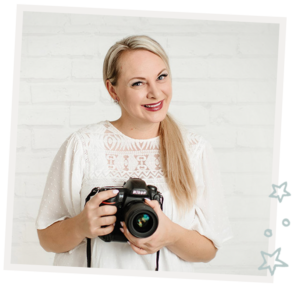
I'm
Lisa DiGeso
I’m on a mission to create uplifting online experiences for photographers ready to elevate their art, their business and their mindset.(...and have fun along the way!)









